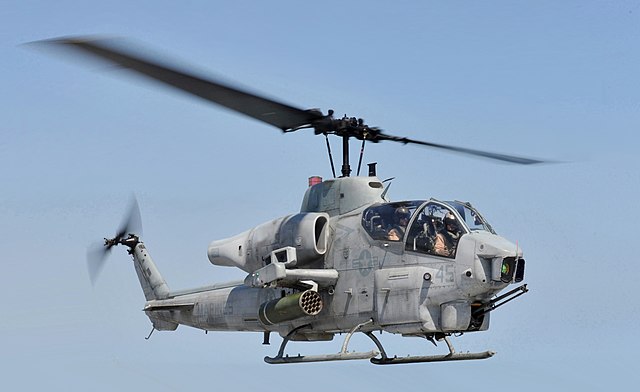In fluid dynamics, disk loading or disc loading is the average pressure change across an actuator disk, such as an airscrew. Airscrews with a relatively low disk loading are typically called rotors, including helicopter main rotors and tail rotors; propellers typically have a higher disk loading. The V-22 Osprey tiltrotor aircraft has a high disk loading relative to a helicopter in the hover mode, but a relatively low disk loading in fixed-wing mode compared to a turboprop aircraft.
The MV-22 Osprey tiltrotor has a relatively high disk loading, producing visible blade tip vortices from condensation of the marine air in this photo of a vertical takeoff.
C-27J Spartan with propeller tip vortices condensation. The C-27J uses the same engines as the MV-22, but has higher disk loading.
Piston-powered light utility helicopters like this Robinson R22 have relatively low main rotor disk loading.
On a helicopter, the main rotor or rotor system is the combination of several rotary wings with a control system, that generates the aerodynamic lift force that supports the weight of the helicopter, and the thrust that counteracts aerodynamic drag in forward flight. Each main rotor is mounted on a vertical mast over the top of the helicopter, as opposed to a helicopter tail rotor, which connects through a combination of drive shaft(s) and gearboxes along the tail boom. The blade pitch is typically controlled by the pilot using the helicopter flight controls. Helicopters are one example of rotary-wing aircraft (rotorcraft). The name is derived from the Greek words helix, helik-, meaning spiral; and pteron meaning wing.
A Bell AH-1 SuperCobra with a semirigid rotor system with a 2-bladed main rotor
NOTAR helicopter with a rotorless tail
Tail Rotor of a Sea Lynx, the smaller tail rotor counter-acts the force of the spinning main rotor in many designs, although there is other solutions to this, such as having two counter-rotating main rotors
Looking up at CH-53G, which has 6-blades on its main rotor







